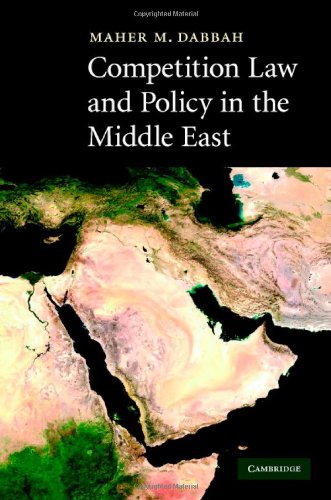Maher M. Dabbah0521869080, 9780521869089, 9780511367595
Table of contents :
Cover……Page 1
Half-title……Page 3
Title……Page 5
Copyright……Page 6
Dedication……Page 7
Contents……Page 9
Preface……Page 19
List of Abbreviations……Page 22
1.1 The Middle East in geographic terms……Page 25
1.2 Geographical coverage of the book……Page 26
1.4 Sharpening the focus……Page 27
1.6 The five issues……Page 28
1.6.1 Foreign direct investment……Page 29
1.6.2 Economic growth and poverty……Page 30
1.6.3 Corporate governance……Page 31
1.6.4 Institutional structure and design……Page 32
1.6.5 Competition advocacy……Page 33
1.7 Regional cooperation: past, present and future……Page 36
1.8 Relationship with the European Community……Page 39
1.10 A book on competition law and policy in the Middle East……Page 41
2.1 The relationship: a myth or reality?……Page 42
2.2 Setting the scene: competition law and Islamic roots……Page 43
2.3 The role of competition law and policy in an economy……Page 44
2.4.1 The Quran……Page 45
2.4.2 The source of Ejtihad……Page 46
2.5.1 The value of trade and competition……Page 47
2.5.2 Pricing practices and policies……Page 48
2.5.3 Abuse of dominance and collusion……Page 50
2.6 Enforcement: the principle and institution of Hisba……Page 51
2.6.1 The origins of Hisba……Page 52
2.6.2 The institutional structure of Hisba……Page 53
2.6.3 Expansion and demise of Hisba……Page 54
2.6.4 Hisba Bill in Pakistan……Page 55
2.7 Conclusions……Page 57
3 Israel: the region’s oldest competition law……Page 58
3.1 The origins of competition law in Israel: the 1959 Law……Page 59
3.2 From the 1959 Law to the 1988 Law and beyond……Page 61
3.3 The path towards effective enforcement……Page 63
3.4.1.1 Definition……Page 65
3.4.1.2 Cartels……Page 69
3.4.1.3 Vertical agreements……Page 70
3.4.1.4 Registration, authorisation and individual exemptions……Page 71
3.4.1.5 The block exemption mechanism……Page 74
3.4.2 Monopolies and monopolists……Page 77
3.4.3 The regulation of mergers……Page 79
3.5.1 The Israel Antitrust Authority……Page 82
3.5.2 The Restrictive Business Practices Tribunal……Page 84
3.5.4 Minister of Industry, Trade and Labour……Page 85
3.6 Orders and penalties……Page 86
3.7 Role of third parties……Page 87
3.8 Competition advocacy……Page 88
3.9.1 Consulting foreign experiences……Page 90
3.9.2 Participation in international organisations……Page 91
3.9.3 Links with the EC and the EFTA States……Page 92
3.9.4 Cooperation with the USA……Page 93
3.10 Reflections……Page 94
3.10.1 Ex ante regulation v. competition……Page 95
3.10.3.1 Adaptation to a restrictive arrangement……Page 96
3.10.3.2 The block exemptions……Page 97
3.10.4 The issue of discretion……Page 98
3.10.6 Non-competition considerations……Page 99
3.10.7 Should the 1988 Law be replaced?……Page 100
4.1 Arriving at the competition law scene: economic, political and social dynamics……Page 102
4.2 The Law on the Protection of Competition……Page 105
4.2.1 Aims, scope and nature……Page 106
4.2.2 Collusion……Page 108
4.2.2.1 The concerted practice presumption……Page 109
4.2.2.2 The treatment of vertical agreements……Page 111
4.2.2.3 Exemptions……Page 112
4.2.3 Abuse of dominance……Page 114
4.2.4 Control of concentrations……Page 116
4.3 The Competition Authority and Competition Board……Page 119
4.3.1 Enforcement and fines……Page 120
4.3.2 Appeal and judicial review……Page 121
4.3.3 Competition advocacy……Page 122
4.5 Regulatory and supervisory aspects of the regime……Page 125
4.6 The burden and standard of proof……Page 129
4.7 Market entry and barriers to entry……Page 130
4.8 International links within the Middle East and beyond……Page 131
4.8.1 The EC–Turkey association……Page 133
4.8.3.1 Turkey–Israel FTA……Page 135
4.8.3.3 Turkey–Palestine FTA……Page 136
4.9.2 Following the EC model……Page 137
4.9.3 The Association and Customs Union Agreements……Page 139
4.9.4 Achievement and progress of the authority……Page 141
4.9.5 The strict time frames……Page 143
4.9.6 General deficiencies……Page 144
4.9.7 The Law and free market……Page 146
4.9.8 Future directions……Page 147
5.1 Algeria: replacing draconian legislation with a mechanism for consultation……Page 149
5.1.1.2 Pricing activities and policies……Page 151
5.1.1.4 Non-competition considerations……Page 152
5.1.2 The role of the Competition Council……Page 153
5.1.2.1 The council’s relationship with other regulators……Page 154
5.1.2.2 Penalties and sanctions……Page 155
5.1.3 International openness and cooperation……Page 156
5.1.4 Comments……Page 157
5.2 Morocco: a strong desire for modernisation……Page 158
5.2.2 The Law on the Freedom of Prices and Competition……Page 159
5.2.2.1 The scheme of the Law……Page 160
5.2.2.2 Free pricing and price regulation……Page 161
5.2.2.3 Consumer protection……Page 162
5.2.2.5 Transparency between professionals……Page 163
5.2.3.1 The Competition Council……Page 164
5.2.3.2 The Commission for Price Supervision……Page 166
5.2.3.3 The Central Committee……Page 167
5.2.4 Penalties……Page 168
5.2.5 Reflections……Page 172
5.3 Tunisia: a pioneer in the Arab world……Page 173
5.3.1 Extensive web of international associations……Page 174
5.3.2 Developing a competition law framework……Page 176
5.3.3.1 Aims and objectives……Page 177
5.3.3.2 Scope of the Act……Page 178
5.3.4.1 The Competition Council……Page 181
5.3.5 Price transparency……Page 184
5.3.6 Reflections……Page 185
5.4.1 The change……Page 187
5.4.3 Liberalisation, privatisation and WTO accession……Page 188
5.4.4 A possible competition law for Libya……Page 190
6 Jordan’s 2004 Competition Law……Page 192
6.1 International outlook and cooperation……Page 193
6.1.2 Jordan–EFTA Free Trade Agreement……Page 194
6.1.3 Jordan–Israel-US QIZ Agreement……Page 195
6.2.1 The failure of the 1990s and the success of 2002……Page 196
6.2.2 The aims of the Act……Page 197
6.2.2.1 Anti-competitive practices……Page 198
6.2.2.2 Abuse of dominance……Page 199
6.2.2.3 Economic concentrations……Page 200
6.2.2.4 Exemptions……Page 202
6.2.3 Price regulation……Page 203
6.3 Institutional structure and the different players……Page 204
6.3.1 The Competition Directorate……Page 205
6.3.2 The Committee for Competition……Page 206
6.3.3 The courts……Page 207
6.4.1 Investigations……Page 208
6.4.2 Penalties……Page 209
6.4.3 Competition advocacy……Page 210
6.4.4 Assessing the performance of the directorate……Page 211
6.5 Market control and supervision……Page 213
6.6 Reflections……Page 214
7 The Gulf States: a possible model for regional cooperation……Page 217
7.1 Measuring the success of the GCC……Page 218
7.1.1 Extrinsic factors: the GCC and other regional communities……Page 219
7.2 International cooperation……Page 220
7.2.2 Cooperation with EFTA States……Page 221
7.3.1 Embracing the free-market system……Page 222
7.3.3 The Competition Act 2004……Page 223
7.3.3.1 Collusion……Page 224
7.3.3.2 Abuse of dominance……Page 225
7.3.3.3 Mergers……Page 227
7.3.4 The Competition Council……Page 228
7.3.5 Orders, penalties, appeal and private enforcement……Page 229
7.3.6.1 The telecommunications sector……Page 230
7.4.1 Building a competitive environment……Page 231
7.4.2 The Law on the Protection of Competition……Page 232
7.4.2.2 Scope of the Law……Page 233
7.4.3 Enforcement……Page 235
7.5 The Republic of Yemen……Page 236
7.5.1 The Competition Law 1999……Page 237
7.5.1.2 Collusion, abuse of dominance and harmful concentrations……Page 238
7.5.2 The Competition Authority……Page 240
7.5.4 An added dimension of regulation……Page 241
7.6.1.1 Overview……Page 242
7.6.1.3 The telecommunications sector……Page 243
7.6.2.1 The Investment Law……Page 245
7.6.2.2 The privatisation programme……Page 246
7.6.2.3 Competition law and policy developments……Page 247
7.6.3.1 The privatisation law and programme……Page 249
7.6.3.2 Competition law tools……Page 250
7.6.3.3 The telecommunications sector……Page 251
7.6.4.1 General……Page 253
7.6.4.2 Price regulation……Page 255
7.6.4.4 Car retail market……Page 256
7.7 Reflections……Page 257
8 The Arab Republic of Egypt: the chase after globalisation……Page 261
8.1 Creating European links……Page 262
8.2 Cooperation with the USA: the qualifying industrial zones……Page 263
8.3 The competition law dilemma……Page 264
8.4 The Law on the Protection of the Freedom of Competition
The Republic of Egypt is one of the latest MECs to adopt specific……Page 266
8.4.2 The scope of the Act……Page 267
8.4.3 Penalties and fines……Page 269
8.5 Institutional structure and capacity……Page 270
8.6 Competition advocacy and international outlook……Page 272
8.8 Cement, steel and telecommunications: from state control to liberalisation……Page 273
8.8.1 The cement industry: a double-edge sword……Page 274
8.8.2 The steel industry: abuse of dominance or freedom of competition……Page 276
8.8.3 The telecommunications sectorthe consequences of liberalisation……Page 278
8.9 Deficiencies, criticisms and concerns……Page 279
8.9.2 The issue of exemption……Page 280
8.9.3 The treatment of abuse of dominance……Page 281
8.9.4 Lack of adequate mechanism for merger control……Page 282
8.9.7 The sectoral application of the Act……Page 283
8.9.8 The frustrating influence of bureaucracy……Page 284
9.1.1 International openness and economic growth……Page 285
9.1.2 The drive for privatisation……Page 288
9.1.3.1 Overview……Page 289
9.1.3.2 The challenges……Page 290
9.1.4 Existing legal framework for protecting competition……Page 291
9.1.5 A modern competition law for Lebanon……Page 293
9.1.6 The scope of the LCA……Page 294
9.1.7.1 The Competition Council……Page 296
9.1.7.2 The rapporteur of competition affairs……Page 297
9.1.9 The public dimension of the LCA……Page 298
9.1.10 Reflections……Page 299
9.2 Syria: resisting international isolation with
international openness……Page 302
9.2.1 Competition law: paradox, contradictions and conflicts……Page 303
9.2.3 The scope and goals of the SCL……Page 305
9.2.3.1 Collusion……Page 306
9.2.3.2 Abuse of dominance……Page 307
9.2.3.3 Merger control……Page 308
9.2.4 Exemptions……Page 309
9.2.6 Improper exercise of intellectual property rights……Page 310
9.2.7 Fairness of commercial transactions……Page 311
9.2.8.1 The Competition Commission……Page 312
9.2.8.2 The Competition Council……Page 313
9.2.9.1 Financial sanctions and penalties……Page 315
9.2.9.3 Settlements……Page 316
9.2.9.6 Damages……Page 317
9.2.10 Reflections……Page 318
10 Conclusions……Page 321
10.1 Competition in Middle Eastern style……Page 322
10.2 Recognising the value of competition and competition law……Page 323
10.3 Different forms of competition law but the same competition policy……Page 325
10.4.1 The Islamic Republic of Iran……Page 327
10.4.1.1 The Constitution……Page 328
10.4.1.4 The competition law scene……Page 329
10.4.2.1 The economy and foreign investment……Page 331
10.4.2.2 WTO membership and privatisation……Page 332
10.4.2.3 Competition law and policy……Page 333
10.4.3.2 Foreign investment……Page 335
10.4.3.3 The competition law scene……Page 336
10.4.4.1 Foreign investment……Page 337
10.4.4.2 Economic and structural reform……Page 338
10.5 The chances for sound cooperation……Page 339
10.5.2 Regional cooperation: myth or reality?……Page 340
10.5.2.1 Cooperation through the European Commission……Page 341
10.5.2.2 Sub-regional cooperation……Page 342
10.5.2.3 Emerging cooperation within the Arab League……Page 343
10.5.3 Comparison with other regions……Page 349
10.6 Competition law: a bridge between civilisations……Page 350
Index……Page 353







Reviews
There are no reviews yet.